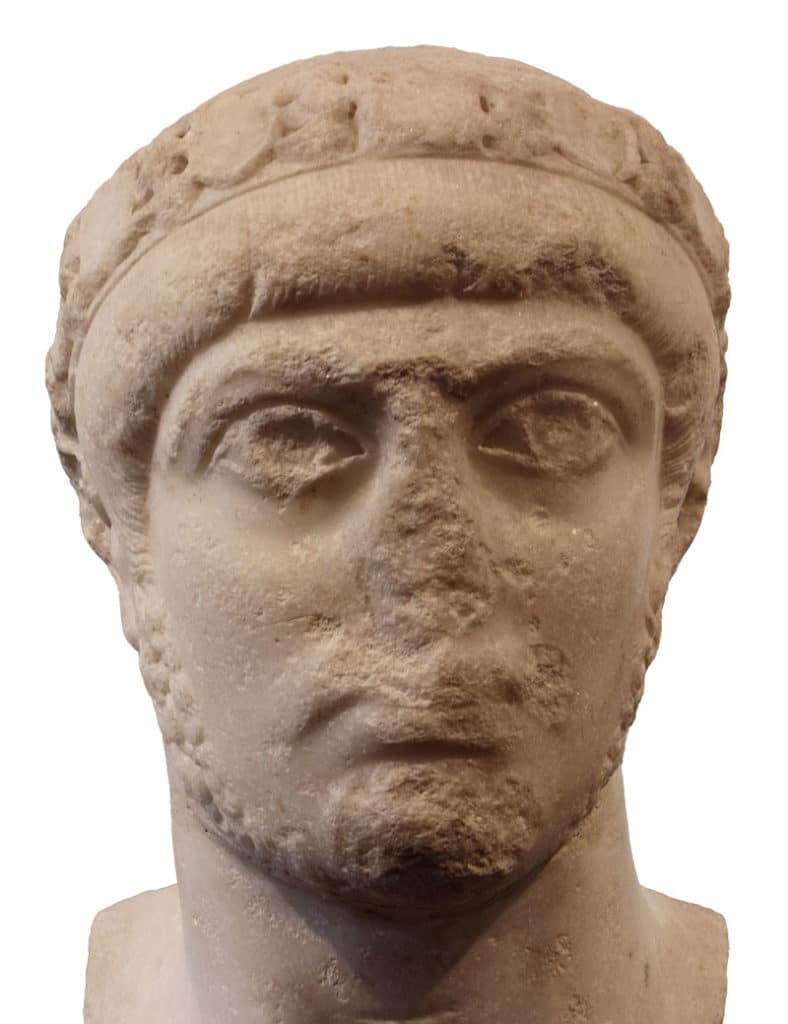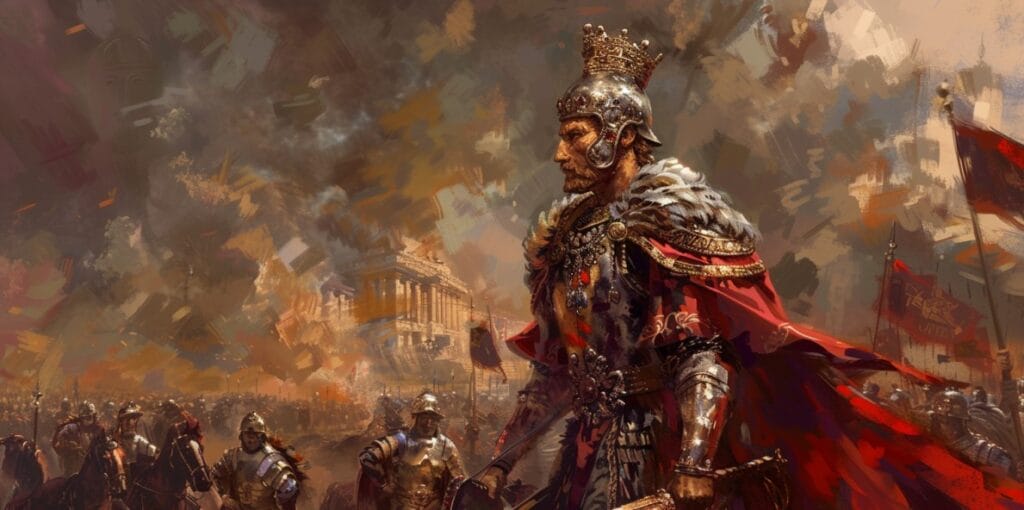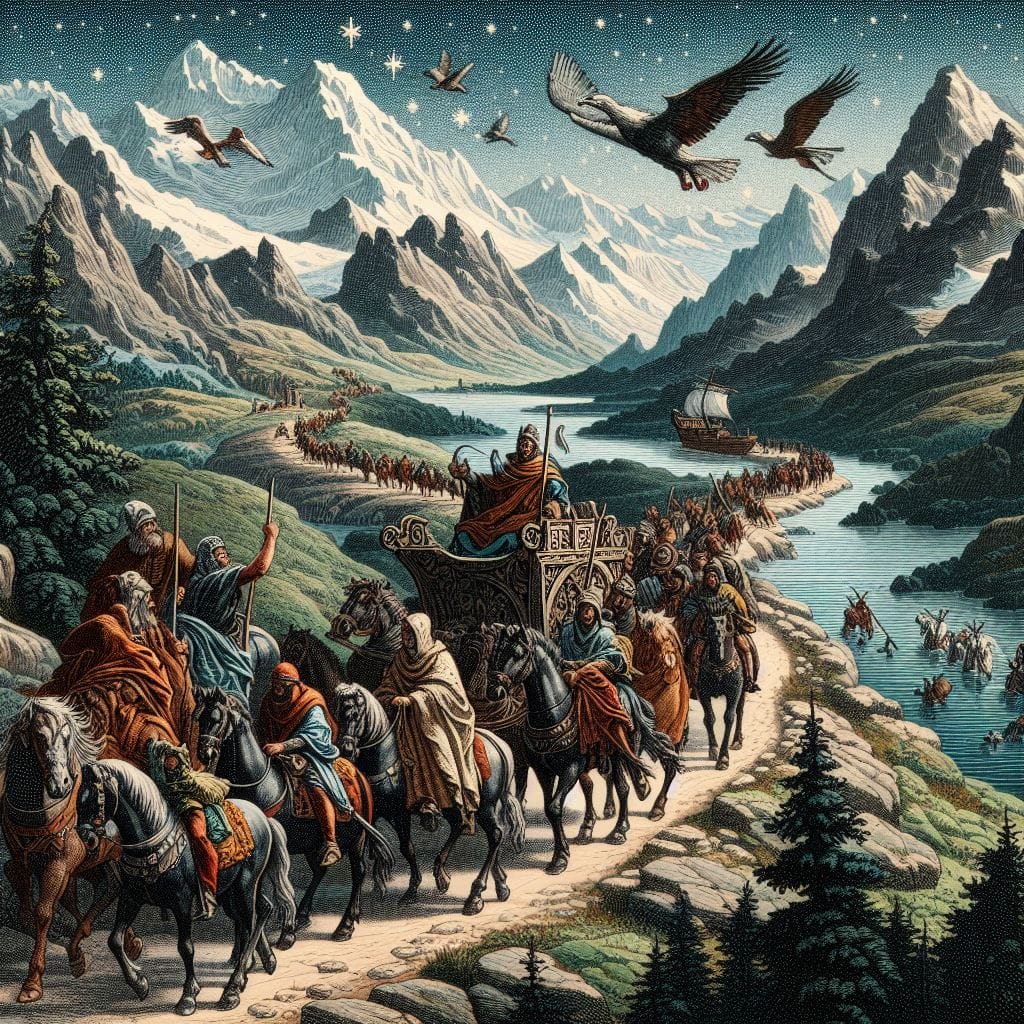Life: AD 359 – 383

- Name: Flavius Gratianus
- Born in AD 359 at Sirmium.
- Became emperor on 17 November in AD 367.
- Wives: (1) Constantia; (2) Laeta.
- Died in Lugdunum (Lyons), August AD 383.
Early Life
Gratian was born at Sirmium in AD 359, the son of Valentinian and Marina Severa. Granted the position of consul by his father in AD 366, he was proclaimed co-Augustus by his father at Ambiani in AD 367.
Becoming the sole Emperor
Gratian became the sole emperor of the West when his father, Valentinian, died on 17 November AD 375. However, his lone reign should last for a mere five days, after which his half-brother Valentinian II was hailed co-Augustus at Aquincum. This happened without the agreement or knowledge of Gratian and his court.
The reason for his brother’s elevation was resentment by the Danubian legions toward the German legions. If Gratian appears to have been in the west when his father suffered a heart attack in the Danubian territory, then the Danubian legions wanted to have some say in who was ruler, evidently resenting that the new emperor was with the German legions in the west.
Childish as the rivalry between the two most powerful army blocks in the empire seemed, it was also very dangerous. To have denied Valentinian II the throne would have meant to enrage the Danubian forces. Hence, he simply accepted the elevation of his brother to the rank of Augustus. As Valentinian II was only four years old, it was at the time of little consequence anyway.
At first, a struggle ensued between those leading court figures who sought to be the power behind the throne. The two leading figures in this struggle were the western ‘Master of Horse,’ Theodosius the Elder, and the praetorian prefect in Gaul, Maximus. For a brief period, their intrigues and conspiracies dominated the court until, eventually, they, in turn, both fell from grace and were put to death for treason.

Ausonius Ruling
This brief period of political conspiracy and maneuvering done with the running of government came to rest with Ausonius, a poet who enjoyed a political career. He continued the policies of broad religious toleration of Valentinian I and ruled with moderation on his emperor’s behalf.
Ausonius also managed to endear himself, as well as his emperor, with the Roman senate. The ancient senate, which appeared at the time still to be dominated by a pagan majority, was treated with great respect and clemency. Some banished senators were granted amnesty, and the assembly was at times consulted, as its advice and support was at last sought again.
Gratians War Against Barbarians
In AD 377 and 378, Gratian campaigned against the Alemanni. He also engaged in some skirmishes with the Alans along the river Danube. On hearing that Valens was facing possible disaster in the east with the Visigothic rebellion, he promised to come to his aid. But he was delayed, apparently by renewed trouble with the Alemanni, before he could start out for the east.

Some have laid the blame for what followed on Gratian, claiming he delayed his assistance intentionally in order to see Valens out of the way, as he resented his uncle’s claim to be senior Augustus. Yet this seems doubtful in the light of the sheer scale of the catastrophe that faced the Roman empire, including his western half. In any case, Valens did not wait for Gratian to arrive. He engaged the Visigothic enemy near Hadrianopolis and was wiped out, losing his own life in the battle (9 August AD 378).
Campaign Against the Visigoths
In response to the catastrophe, Gratian recalled Theodosius (his wife’s cousin and the son of Theodosius the Elder) from his exile in Spain to campaign on his behalf along the Danube against the Visigoths. The campaign met with considerable success, and Theodosius was rewarded by being raised to the rank of Augustus of the East on 19 January AD 379 at Sirmium.
Had Gratian all his life been a devout Christian, then this most likely contributed to the increasing influence of Ambrose, bishop of Mediolanum (Milan) enjoyed over the emperor. In AD 379, he not only began to persecute all Christian heresy but also dropped the title of pontifex maximus – the first emperor ever to do this. This hardening of religious policy is very much indeed the good work that had been previously done by Ausonius in creating unity by showing religious tolerance.

For the year AD 380, Gratian joined Theodosius in further campaigns along the Danube, resulting in the settlement of some Goths and Alans in Pannonia. But as bishop Ambrose’s influence over Gratian grew, his popularity began to fall drastically. When the senate sent a delegation to discuss the emperor’s controversial religious policy, he would not even grant them an audience.
The Fall of Gratian
More critically, Gratian also lost the support of the army. Had the emperor granted special privileges to Alan mercenaries, then this alienated the rest of the army. Alas, in AD 383, news reached Gratian in Raetia that Magnus Maximus had been hailed emperor in Britain and had crossed the Channel into Gaul.

Gratian at once marched his army to Lutetia to meet the usurper in battle, but he simply no longer commanded enough support among his men. His troops deserted him, changing their allegiance to his rival without a fight. The emperor fled and, with his friends, sought to reach the Alps, but in August AD 383, a senior officer joined them at Lugdunum, claiming to be one of his remaining supporters. The officer’s name was Andragathius, and, in truth, he was one of Maximus’ men. Having managed to get close to Gratian, he waited for the right opportunity and assassinated him (August AD 383).
People Also Ask:
What was Gratian known for?
Gratian (Latin: Gratianus; 18 April 359 – 25 August 383) was emperor of the Western Roman Empire from 367 to 383. The eldest son of Valentinian I, Gratian, was raised to the rank of Augustus as a child and inherited the West after his father’s death in 375.
How old was Gratian when he became emperor?
With the death of Valentinian I in the east, Valens became the senior Augustus, and the 16-year-old Gratian was the only Augustus in the Western empire.
How long did Theodosius rule?
Theodosius I (Greek: Θεοδόσιος Theodosios; 11 January 347 – 17 January 395), also called Theodosius the Great, was Roman emperor from 379 to 395.
How did Gratian become emperor?
Upon the death of Valentinian in 375, Gratian took over the government of the West while his half-brother Valentinian II was also acclaimed emperor in Pannonia. Gratian governed the western provinces of the empire, while his uncle Valens was already the emperor over the east.
How did Emperor Gratian Die?
Gratian was pursued by Andragathius, Maximus’ magister equitum, and killed at Lugdunum (Lyon) on 25 August 383, according to the Consularia Constantinopolitana. Maximus then established his court at the former imperial residence in Trier.

Historian Franco Cavazzi dedicated hundreds of hours of his life to creating this website, roman-empire.net as a trove of educational material on this fascinating period of history. His work has been cited in a number of textbooks on the Roman Empire and mentioned on numerous publications such as the New York Times, PBS, The Guardian, and many more.
